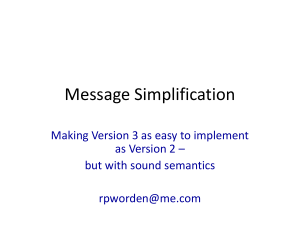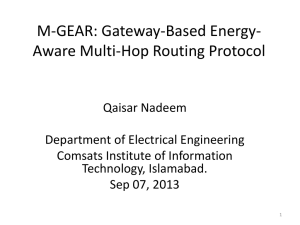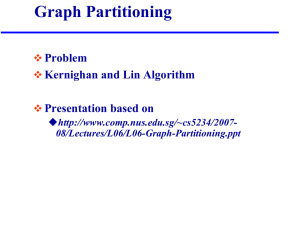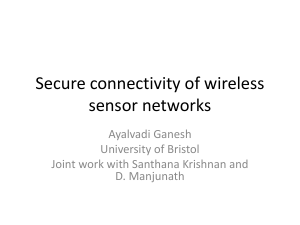pptx - Nadeem Javaid
advertisement
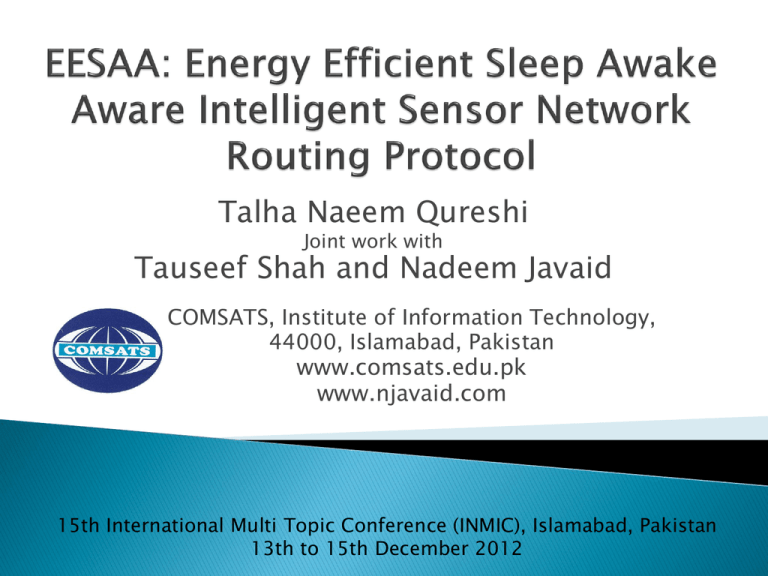
Talha Naeem Qureshi Joint work with Tauseef Shah and Nadeem Javaid COMSATS, Institute of Information Technology, 44000, Islamabad, Pakistan www.comsats.edu.pk www.njavaid.com 15th International Multi Topic Conference (INMIC), Islamabad, Pakistan 13th to 15th December 2012 Wireless Sensor Networks (WSNs) are composed of multiple unattended ultra-small, limited-power sensor nodes Sensor nodes are deployed randomly in the area of interest Sensor nodes have limited processing, wireless communication and power resource capabilities Sensor nodes send sensed data to sink or Base Station (BS) Goal: o Prolong network lifetime/coverage Clustering is useful in reducing energy consumption LEACH – Low Energy Adaptive Clustering Hierarchy [Heinzelman et al., 2000] SEP - Stable Election Protocol [G. Smaragdakis et al., 2004] DEEC - Distributed Energy Efficient Clustering [Li Qing et al., 2006] LEACH: where: ◦ Unable to differentiate nodes in terms of energy (homogeneous) ◦ Node i chooses random number s between 0 and 1 ◦ If s < T(si), node i becomes a Cluster Head (CH) for the current round where: ◦ T(si)=threshold ◦ Pi = desired percentage of CHs ◦ G = set of nodes that have not been a CH in the last 1/P rounds Each node is elected CH once every 1/P rounds (epoch length) On average, n x P nodes elected per round ◦ n = total number of nodes Differentiate nodes in terms of their energy (heterogeneous) Consider two types of nodes w.r.t energy: normal and advanced nodes where: ◦ Energy of advanced nodes > Energy of normal nodes CH selection probability of advanced nodes is greater than normal nodes Use same threshold T(si) for CH selection as described by LEACH Each node is elected CH once every 1/P rounds (epoch length) Epoch of advanced nodes < epoch of normal nodes Differentiate nodes in terms of their energy (heterogeneous) Consider multiple energy levels of nodes Use same threshold T(si) for CH selection as described by LEACH Epoch of high energy nodes < epoch of low energy nodes Mostly sensor nodes overlaps each other or placed close to each other during deployment Overlapped and close nodes have same sensed data There is no need to send same sensed data two times to BS Sending same data two times to BS cause ◦ Energy loss ◦ Stability period and life time of WSN decreases ◦ Extra overhead on sink No previous protocol including LEACH, SEP and DEEC is addressing this issue Our goal: ◦ To minimize energy consumption ◦ To enhance network stability period and network lifetime. Concept of pairing is introduced Sensor nodes of same application and at minimum distance between them will form a pair for data sensing and communication CHs selection technique is enhanced CH selection on basis of remaining energy of nodes CH of current round will predict the CH for next round Mechanism: ◦ Sensor nodes are supposed to be equipped with Global Positioning System (GPS) ◦ Senor nodes measure their location through GPS ◦ Nodes transmit their location information to sink ◦ In first round clusters are formed by same mechanism described by LEACH ◦ Nodes which are at minimum distance from each other in their intra cluster transmission range and of same application type are coupled in pair by BS Mechanism: ◦ Sink broadcast pairing information to all the nodes in network ◦ Nodes become aware of their coupled node According to the proposed scheme, The nodes switch between ”Sleep” and ”Awake” mode during a single communication Interval Initially node in a pair, switch into Awake mode also called Active-mode if its distance from the sink is less then its coupled node Node in Active-mode will gather data from surroundings and transmit data to CHs During this period transceiver of the coupled node will remain off and switches into Sleep-mode In next round, nodes in Active-mode switch into Sleep-mode and Sleep-mode nodes switch into active-mode Energy consumption is minimized because nodes in Sleep-modes save their energy by not communicating with the CHs Unpaired nodes remain in Active-mode for every round till their energy resources depleted Green circles – coupled or paired nodes Read circles – unpaired or isolated nodes CH selection mechanism: ◦ Initially, in first round CHs are selected by same mechanism described by LEACH ◦ CHs selection after first round is based on remaining energy of each node ◦ Nodes in Active-mode take participation in CH election process ◦ During start of round, nodes also transmit their energy information to CH ◦ CH computes the remaining energy of every node in cluster and its distance from each node and select CH for the next upcoming round Transmission phase: ◦ When node has been selected as CH, it broadcasts an advertisement message to whole network. ◦ Only Active-mode nodes hear the broadcast advertisements from different CHs ◦ They select their CHs on the basis of Received Signal Strength Indication (RSSI) of advertisements Nodes in Active-mode, transmit their sensed data to CH during their assigned TDMA slots Nodes in Sleep-mode do not take participation in data transmission and save their energy by turning their transceiver off Node mode setup algorithm Performance metrics: ◦ Stability period: It is duration of network operation from start till first node dies ◦ Network lifetime: Network lifetime is duration from start till last node is alive ◦ Instability period: It is duration of network operation from first node dies till the least node dies ◦ Number of CHs: It indicates the number of clusters generated per round ◦ Packet to BS: It is rate of successful data delivery to BS from CHs In EESAA first node dies around 1800 round Stability period of EESAA is almost 120% 50% and 35% greater than LEACH, SEP and DEEC respectively EESAA has 100% 102% and 50% network lifetime as compared to LEACH, SEP and DEEC SEP, DEEC and LEACH has more uncertainties in CHs selection Random number of CHs are selected in every round but ESSA has controlled CHs selection. EESAA efficient CHs selection algorithm helps it in better and constant data rate transmission to BS EESAA has sleep-awake policy for nodes Less number of data is transmitted to BS in starting rounds due to sleep mode of some nodes But after 4300 rounds, EESAA has highest data rate EESAA is location aware protocol EESAA minimizes energy consumption by sleep-awake mechanism Simulation results show significant improvement all performance metrics as compared to existing routing protocols e.g., SEP, LEACH and DEEC For more information please check www.njavaid.com

